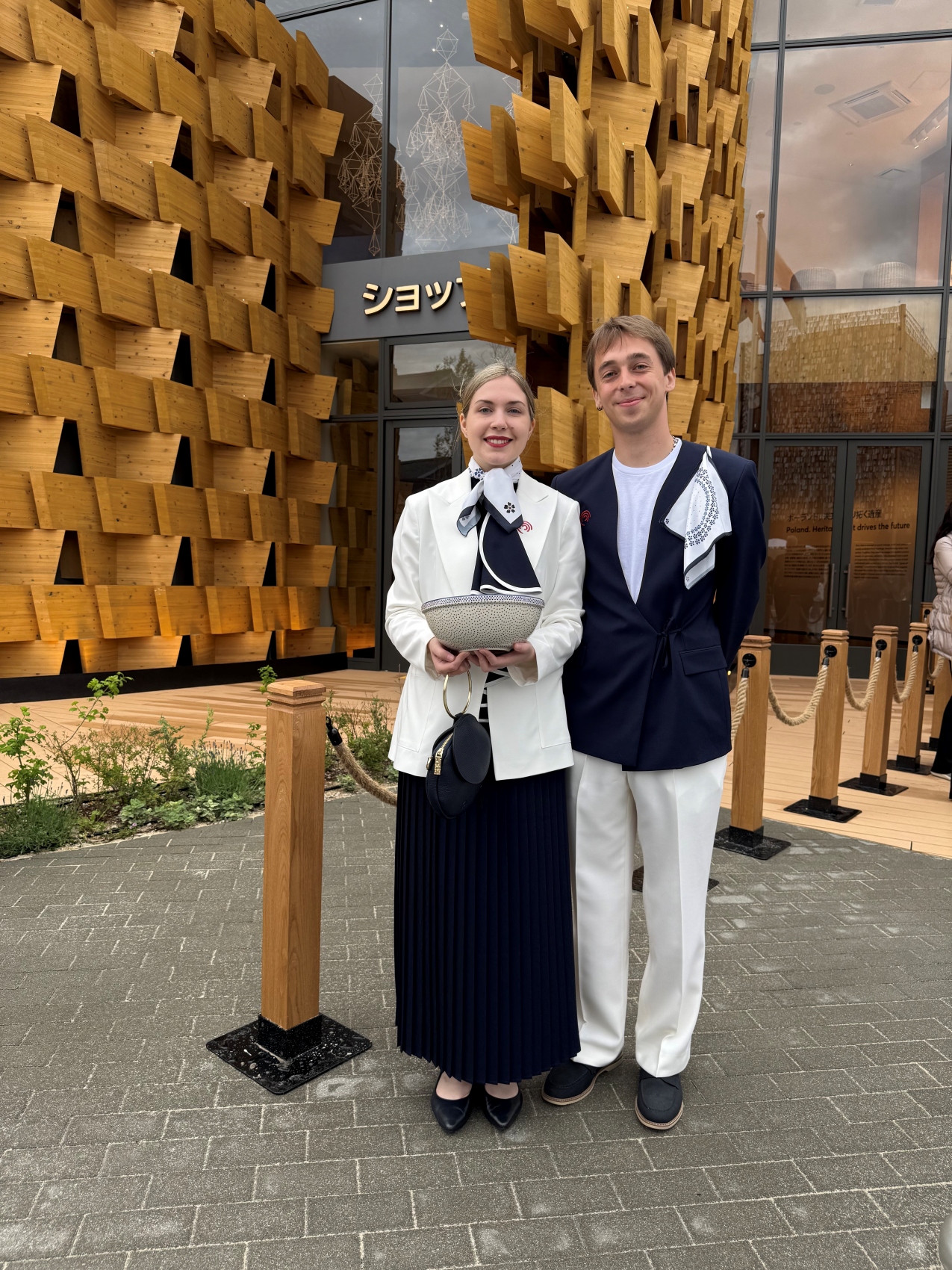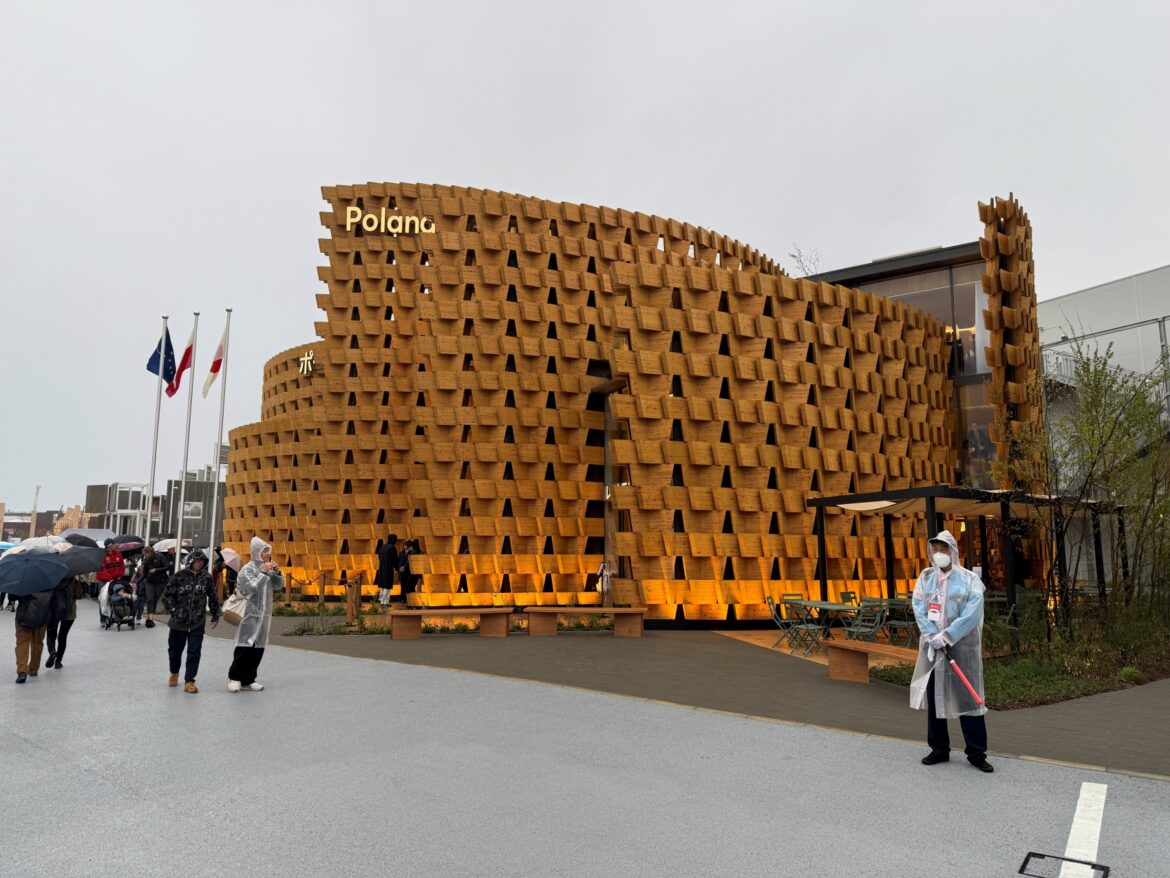The official opening of the World Expo 2025 in Osaka took place on Sunday 13 April. For the next six months, pavilions of countries from all over the world will be on display. Among the countries that have decided to build their own building is Poland. Decorated with a wooden façade, the pavilion can easily be counted among the most beautiful. The arrangement prepared inside also stands out, and was eagerly visited by the Japanese.
The World Expo 2025 Osaka, Kansai will run until 13 October 2025. This is the second Expo to be held in Japan (the first was in 1970). The infrastructure of the Expo was built on the artificial island of Yumeshima, which was a dumping ground in the 1970s. In the 1990s, the island was expanded, putting in new infrastructure and enlarging it to an area of 155 hectares. Today, pavilions of 158 countries can be visited in this area.
The Polish Pavilion at Expo 2025 was designed by Alicja Kubicka and Borja Martínez of Interplay Architects. The building has an area of nearly 1,000 square metres. The architects proposed a spiral form to evoke the association of the spreading wave of creativity of Poles. This refers to the pavilion’s slogan: “Poland. Heritage that fuels the future’.
Building elevation:


From the outset, we knew that the Pavilion’s external form had to be original and original in order to encourage visitors to visit this particular building among the many unusual structures. In addition, the pavilion’s privileged location – situated in an exposed corner – allowed us to create an attractive design seen from different perspectives and in motion, rather than from one main and static view. The starting point was the concert hall: the Japanese love Chopin, and concerts dedicated to his works will be one of the highlights of the programme. We placed it in a central location. We then tried to create a flowing tour path and to organise all the other functions so that they revolve around the geometric heart of the Pavilion. This move not only symbolises the importance of culture, which sets us apart from others, but also with the open and concentric arms of the spiral invites you to enter the “Polish galaxy” zone – explain architects Alicja Kubicka and Borja Martínez.
The Polish Pavilion. Exhibition
The entrance to the pavilion, located in the middle, leads visitors to the successive exhibition rooms. From the lobby, visitors head to the first floor, where they will find the Spirit Plant exhibition. On interactive screens, visitors can have fun designing their ideal plant and learn interesting facts about the herbs growing in Poland. The created plant can be downloaded to your phone and shared on social media. “Generations” is a dynamic gallery that uses parametric “Spirit Plant” plants created by Pavilion visitors. The animated herbarium “Seven Herbs” introduces visitors to the tradition of Polish herbalism, while referencing the history of the Polish school of illustration. The “Most Polish Landscape”, on the other hand, is a visualisation prepared using artificial intelligence, which is created in front of visitors’ eyes. The beautiful landscapes are ideal representations of the Polish landscape. “Aura” is a unique digitally controlled orchestra, organically extracting sounds from natural materials and combining technology with traditional craftsmanship. “Aura” could become the biggest magnet of the Poland Pavilion. The installation consists of dozens of small brushes made of natural materials, which rotate and cause friction to produce a distinctive sound. The movement of the brushes has been programmed to interpret the works of Fryderyk Chopin. The installation is noteworthy especially when compared to exhibitions in other countries’ pavilions, which rely on visual effects and dynamic sounds. Poland’s ‘Aura’, on the contrary, allows for a moment of tranquillity and disconnection from stimuli.
The composition ‘Verses’, on the other hand, harmoniously combines the Japanese with the Polish by placing hundreds of haiku poems by Polish haijin in the space . Daily piano recitals are planned in one of the rooms; works by the Polish composer will be played by participants in Chopin competitions for six months, three times a day.
How much did the Polish Pavilion at the Osaka EXPO cost?
The Polish Investment and Trade Agency is responsible for Poland’s participation at the Expo, and the Ministry of Development and Technology is the supervising institution. An amount of PLN 165 million has been set aside for the entire project. Despite rising costs, the organisers assure that this amount will not be exceeded. Although the amount seems huge, it does not only refer to the construction of the building, but also includes staff salaries, transport of materials, exhibitions, people involved, accommodation or promotion. The Polish Pavilion is operated by 48 Japanese Studies students from Polish universities.
The construction of the pavilion was a major challenge due to local building laws and technical requirements related to earthquake risk, among other things. The pavilion must be resilient and ensure the safety of those inside. This made the cost of Poland’s presence at the Expo in Japan higher than in Dubai. For Poland’s participation in the Expo 2020 World Expo in Dubai, PLN 84 million was spent. The UAE was more flexible on legal, technical or material issues. The lower cost of Poland’s participation was also influenced by the country’s closer location and easier transport of goods.

Poles set the record
The Polish Pavilion was built at a surprisingly fast pace. It took just seven months to build, which was much appreciated by the Japanese hosts. Despite the fast work, the pavilion did not lose any quality and its creators did not compromise. Of the 42 Category A pavilions (stand-alone pavilions), the Polish building was built the fastest. Why do we mention this? Because it is precisely because of strict regulations that some countries have not managed to open the doors of their buildings to visitors. Examples include Brazil and India, which were still busy with finishing work on the opening day.
The World Expo 2025 is an opportunity to promote Poland internationally, as well as a space for building relationships and exchanging experiences at the highest level. In a world that is changing at a rapid pace, we are showcasing Poland as a country that combines tradition with modernity and our innovative approach to technology, sustainable development and international cooperation. I am convinced that our presence in Osaka will contribute to the establishment of long-term partnerships and strengthen Poland’s position as an important player on the global economic and cultural scene,” says Jacek Tomczak, Commissioner General of the Polish Section of the World Expo 2025 Osaka, Kansai.
The whiteMAD editorial team spent a week in Japan. Over the course of several days, we were able to visit the pavilions of many countries, including from the inside. We can confidently say that the Polish Pavilion is among the best. A similar opinion is held by the editors of the American New York Times, who ranked the Polish Pavilion among the 25 most important things and events of Expo 2025. We will continue to write about what other countries’ pavilions look like, so fans are encouraged to check out our website.
The Polish Pavilion was built by a consortium including Nagashima Co., Ltd, JSC Corporation, FINASI SPI JV TURNKEY PROJECTS CONTRACTING – FZCO.
source: own elaboration
Read also: Wood | Facade | Detail | Interesting facts | Featured | whiteMAD on Instagram
Poland Pavilion:


AloJapan.com